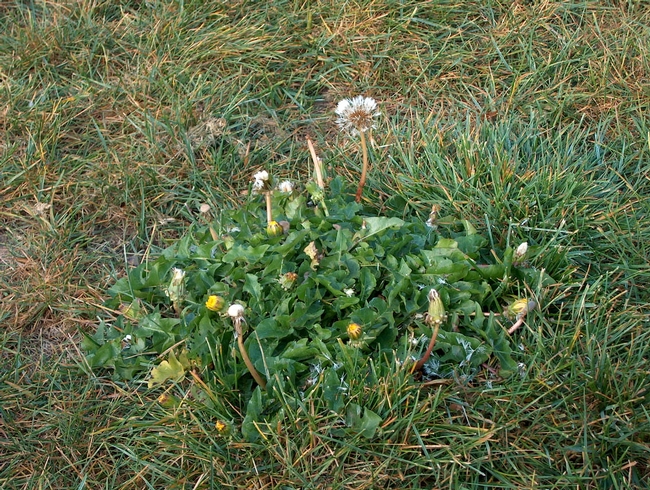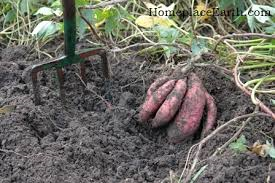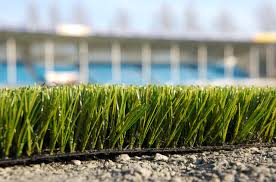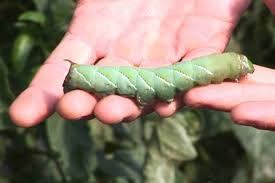
Sure enough,a little research enlightened me about the good side of this troublesome weed. The dandelion that grows in the Napa Valley (Taraxacumofficinale) is, in my opinion, a major problem in the garden. Thriving in just about any garden venue, dandelions have a taproot that is hard to remove permanently.
The dandelion has been used as a pot herb and medicinal plant since Roman times. The seeds were so valued that people carried them on the Mayflower to the New World. High in vitamins and minerals, the young leaves are eaten in salads; the mature blossoms scent dandelion wine; and the roots are brewed for a coffee substitute. The dried leaves can be steeped for a mild tea, and the dried roots are a mild diuretic. I remember, as a child, seeing my dad come in from the yard with fresh dandelion leaves for the salad. My mom was not amused.
I am sure that my fellow gardeners agree that these plants are persistent. Although the taproot does break up the soil and provide nutrients for other plants, I'm not ready to give it any encouragement yet.
I have worked and worked to remove dandelions from my lawn, positive that I had the entire root structure only to have this annoying plant re-emerge in a few weeks. Dandelions prefer moist areas in full sun but can survive in some shade and dry soil if they get established.
The plant grows pretty much year-round in California except in the coldest areas, where it lies in wait for warmer weather. The taproot, while usually only 6 to 8 inches long, can reach 10 to 15 feet. No wonder I have a problem getting it all.
The leaves grow in a rosette.They have no true stems. Leaves are usually two to four inches wide and about up to fourteen inches long. Some have smooth edges; others have a jagged, tooth-like appearance that explains the plant's name. Dandelion comes from “dent de lion,” which is French for lion's tooth.
As a child, I picked the flowers to make necklaces, and then blew on the seed balls to watch the puffs float on the wind. No wonder this plant is prevalent. The seed heads have up to 300 seeds, which can travel by wind, sometimes helped by the breath of children, for miles.
There are more than 60 dandelion species. Taraxacumofficinale has small leaves, so harvesting them is labor intensive. If you are thinking of selling your crop, that idea is probably a “no go.” The summer dandelion is more upright, with larger leaves that are easier to harvest. For the most part, the variety sold in grocery stores is a hybrid of the chicories‘San Pasquale' and ‘Catalogna'. Commercial dandelion farmers are required to control their seed in some manner. Can you imagine living downwind from a dandelion farm?
The most interesting species of dandelion by far is the Taraxacumkoki-saghyz, also known as TKS or Russian dandelion. This variety has greyish upright foliage and more natural latex than the others types. During World War II, rubber supplies were sorely depleted. The Swedish Seed Association conducted a dandelion breeding program to increase the latex content in the root. The new TKS produced four to five times more usable latex than the common dandelion.
The Swedish study had been back-burnered until recently, when automotive-industry researchers began investigating TKS as a source of rubber for tires. Other scientists are looking closely at the hypoallergenic properties of the latex from this species, and exploring whether it could be used as a source of ethanol.So as you wrestle with dandelions in your landscape, keep its positive attributes in mind. One gardener's weed is another person's dinner.
Workshop: Napa County Master Gardeners will conduct a workshop on “Habitat Gardens at Home or School” on Saturday, May 16, from 9:30 a.m. to 11:30 a.m., at Skyline Park, Martha Walker Garden, 2201 Imola Avenue, Napa. Participants will tour the Martha Walker Garden to discover the plants and garden elements that attract bees, birds and pollinators. Master Gardeners will explain the value of habitat corridors whether the garden is in a rural, urban, or school setting. Online registration (credit card only) Mail-in registration (cash or check only)
Master Gardeners are volunteers who help the University of California reach the gardening public with home gardening information. Napa County Master Gardeners ( http://ucanr.org/ucmgnapa/) are available to answer gardening questions in person or by phone, Monday, Wednesday and Friday, 9 a.m. to Noon, at the U. C. Cooperative Extension office, 1710 Soscol Avenue, Suite 4, Napa, 707-253-4143, or from outside City of Napa toll-free at 877-279-3065. Or e-mail your garden questions by following the guidelines on our web site. Click on Napa, then on Have Garden Questions? Find us on Facebook under UC Master Gardeners of Napa County.


Sweet potatoes aren't started from seed like most other vegetables. Rather, they are started from slips, which are shoots from a mature sweet potato. When I wasn't able to find sweet potato slips at local nurseries, I did what I usually do when I have a need. I Googled “sweet potato slips” and found quite a few online sources.
Most of them did not ship to California. On the California Department of Food and Agriculture's website, I learned that certain states are prohibited from shipping sweet potatoes to California because of the presence of the sweet potato weevil in those states. If I wanted sweet potato slips, I would have to find a source that was not in Alabama, Arkansas, Florida, Georgia, Hawaii, Louisiana, Mississippi, South Carolina, Tennessee or Texas. Fortunately there is a source in Virginia.
Sweet potatoes slips are shipped from Mid-May to early June. Once received, they should be planted within a few days.
Before your slips arrive, you have a little work to do. Sweet potatoes need loose, well-drained soil to form large tubers. Loose soil is more critical than almost any other factor. You don't want the roots to face resistance when they try to expand.
If you have clay soil or drainage problems, work in lots of compost. I have both, so I grow all of my vegetables in raised beds to which I have added four to five inches of compost. Sweet potatoes grow best in moderate to slightly acidic soil so pH should be in the 5.5 to 6.5 range. If your soil pH is higher than that, add more compost but don't expect the pH to change overnight.
Plant slips 2 to 3 inches deep and 12 to 18 inches apart, with the leaves above ground. Space rows 3 feet apart if possible to accommodate the sprawling vines. Plant in late afternoon so that the slips can settle in before being exposed to direct sun.
Give plants a thorough soaking after planting. Water daily for the first week, then every other day the second week. Each week, space the watering a little farther apart until you're watering once a week. Sweet potatoes can withstand drought but they'll produce less, so make sure you keep the ground moist during the hottest part of the summer. Regular watering will assure a larger harvest, and even moisture will help prevent splitting and cracking.
Like other vegetables, sweet potatoes don't like to compete with weeds for soil nutrients and water. Start with a weed-free environment and then keep it that way. Your sweet potatoes will soon produce foliage that will crowd out weeds, so you only need to be vigilant for a short time.
Historically, sweet potatoes have been regarded as a poor-soil crop, one that produces a decent harvest in imperfect soil. But they do much better with a little fertilizer. About two weeks after planting, feed with a balanced organic fertilizer such as 5-10-10. Use about 2 cups per 30 square feet (the size of a 4x8 raised bed). Gently scratch the fertilizer into the soil. Then cover soil with an inch of your favorite mulch.
Harvest sweet potatoes when they reach your preferred size. Dig one up when your crop reaches the recommended growing time for the variety (generally between 90 and 120 days.) If the tubers are still too small for your liking, try again in a week. Sweet potatoes left in the ground will continue growing until frost, although growth slows as the weather cools. For best storage quality, harvest sweet potatoes before the soil temperature drops below 55°F.
Sweet potatoes require a curing process to heal any scratches or other damage, develop sweetness and improve storage quality. Immediately after harvest, let the sweet potatoes dry fully, then shake off excess soil. Do not wash the sweet potatoes. Cure them by keeping them at 90 percent relative humidity and 85°F for seven to ten days.
For long-term storage after curing, choose firm, round, bruise-free, well-shaped sweet potatoes with fairly even coloring. Store them in a cool (over 55°F), dry, well-ventilated area away from light. Do not refrigerate sweet potatoes unless they are already cooked. Cold temperatures will give sweet potatoes a hard core and affect the flavor. Properly cured sweet potatoes should store for 5 to 12 months unrefrigerated.
Workshop: Napa County Master Gardeners will conduct a workshop on “Habitat Gardens at Home or School” on Saturday, May 16, from 9:30 a.m. to 11:30 a.m., at Skyline Park, Martha Walker Garden, 2201 Imola Avenue, Napa. Participants will tour the Martha Walker Garden to discover the plants and garden elements that attract bees, birds and pollinators. Master Gardeners will explain the value of habitat corridors whether the garden is in a rural, urban, or school setting.Online registration (credit card only)Mail-in registration (cash or check only)
Master Gardeners are volunteers who help the University of California reach the gardening public with home gardening information. Napa County Master Gardeners ( http://ucanr.org/ucmgnapa/) are available to answer gardening questions in person or by phone, Monday, Wednesday and Friday, 9 a.m. to Noon, at the U. C. Cooperative Extension office, 1710 Soscol Avenue, Suite 4, Napa, 707-253-4143, or from outside City of Napa toll-free at 877-279-3065. Or e-mail your garden questions by following the guidelines on our web site. Click on Napa, then on Have Garden Questions? Find us on Facebook under UC Master Gardeners of Napa County.
The allure of stalking game wasn't something I understood until I spent a perfect day planting seedlings only to discover the next morning that said seedlings had disappeared. In cartoons, you have probably seen red-faced people with steam coming out of their ears. That was me.
I am now on a mission. I hunt the information highway for ammunition and stalk game in my yard. I now understand the thrill of the hunt. Learning how to vanquish a certain pest and implementing the technique in my garden makes my day.
Early on I decided that I was going to avoid chemical warfare. So I comb the library and the Internet and question acquaintances and sometimes complete strangers for information and success stories. Here is my hit list:
Earwigs are one common problem in my garden. I was surprised to learn that they are considered somewhat beneficial as they eat soft-bodied insects and their eggs. I chose to control them because they damage seedlings and soft fruit.
Earwigs like moist, dense undergrowth and debris, so control them by installing a drip system and cleaning up detritus. Check plant support stakes. If they are hollow, replace them. Earwigs hide inside hollow stakes during the day.
Trap earwigs with rolled-up newspaper, short pieces of hose or toilet paper rolls. Place your choice of traps near the affected area at dusk. In the morning, collect traps and shake them out over a bowl of soapy water.
Another tactic is to bury a tuna or cat-food tin up to the rim. Add 2 tablespoons vegetable oil and a small amount of bacon grease or fish oil as an attractant. Check daily and dump out any dead insects; refill with oil and replace the trap. After a week of diligence, you should notice a marked decrease in population. Then just stay on top of it. If it looks like earwigs are returning, repeat the process.
Hornworms are a huge pest, literally. One of my friends said that the first time she saw one, she screamed so loud that her husband came running. The best way to deal with these meaty monsters is to don garden gloves and either hand-pick them or, as my friend does, use kitchen tongs. If you have chickens or other fowl, you will make their day by flinging this rotund pest into their area.
There are not many plants that aphids don't like. However, they rarely kill plants, and you can usually wash them off with water or squish them. Interestingly, they tend to avoid plants that have their squashed brethren on them.
To control aphids, I make a 10 percent blend of non-detergent liquid dish soap and water and spray it directly on the plant. Wherever you find aphids, you will likely find ants. Get rid of the ants and the aphids have no protection from predators. When aphid populations climb, natural enemies like lady beetles and lacewings descend to feed on them.
According to lore, a Frenchman introduced snails to California during the Gold Rush—a food crop that went horribly wrong. Their overwhelming number today substantiates my belief that messing with Mother Nature has consequences. Snail presence in the garden is unmistakable because of the slimy trails they leave behind. Remove moist environments and clean up debris to control them. In my experience, the best traps are 12”x12” boards randomly laid around the yard. I go outside early in the morning, turn each board over and smash the attached snails. Keep at it for a week and you will prevail; then you just need to monitor for signs of their return.
Beneficial insects play a role, too. My kids and I purchased lady beetles one year and enjoyed the experience. Purchase lady beetles that have been kept under refrigeration and release them at dusk for best results.
The University of California's IPM web site (http://www.ipm.ucdavis.edu/PMG/PESTNOTES/) has extensive information on pest control. I have had great success implementing this research in my garden, and I believe that you, too, will reap the rewards.
Master Gardeners are volunteers who help the University of California reach the gardening public with home gardening information. Napa County Master Gardeners ( http://ucanr.org/ucmgnapa/) are available to answer gardening questions in person or by phone, Monday, Wednesday and Friday, 9 a.m. to Noon, at the U. C. Cooperative Extension office, 1710 Soscol Avenue, Suite 4, Napa, 707-253-4143, or from outside City of Napa toll-free at 877-279-3065. Or e-mail your garden questions by following the guidelines on our web site. Click on Napa, then on Have Garden Questions? Find us on Facebook under UC Master Gardeners of Napa County.


If you have time and money to invest, you will only have to mow, de-thatch, rake, weed, fertilize and remove animal waste from your lawn. The University of California at Davis's Integrated Pest Management website has a lot of information about how to care for your lawn (http://www.ipm.ucdavis.edu/TOOLS/TURF/RENOVATE/index.html).
The tips and techniques found on this site will help you limit, if not preclude, the use of herbicides. By using less herbicide, you limit your exposure, and that of your pets and surrounding plants, to toxic chemicals.
However, the time you spend following these tips is time not spent relaxing on your lawn. I am exhausted thinking about the maintenance required by natural grass. And we can't forget watering. Lawns are, by far, the thirstiest part of a landscape. Over a year, the cost of watering a lawn can be as expensive as a short Hawaiian vacation.
I prefer an annual Hawaiian vacation over a nice lawn. That's why I installed synthetic grass in my yard. After six years, my synthetic lawn looks as great as it did when installed. It hasn't faded from the sun or begun to degrade from the elements. The only maintenance my lawn requires is an occasional pass with a leaf blower to give it a fresh-mowed look.
When it's in direct sun, the synthetic grass can get hot, which is also often the case with natural grass. Most synthetic turf reflects light, reducing the amount of heat it will absorb and limiting fading. You can place patio furniture on a synthetic lawn without damaging the turf. I do use rubber coasters under furniture legs to distribute the weight, but that's just for peace of mind.
With synthetic turf, you don't have to worry about subterranean creatures digging holes, as they do in natural turf. The base fabric is strong enough to prevent animals from digging or chewing through it, while still porous enough that water will drain through.
The product has come a long way since it was first introduced in 1965 in the new Houston Astrodome and given the moniker “Astroturf.” There are numerous brands, with a choice of colors and pile height. Golfers can even have a putting green installed.
To provide the cushioned feel of natural grass, synthetic grass has a fill of either sand, fractured rubber or a combination. This fill keeps the grass upright, prevents matting and serves as an excellent weed barrier.
Proper installation of a synthetic lawn requires more than just cutting, measuring and unrolling. Installation should be performed by a licensed landscape contractor who is proficient with the product. A conscientious contractor will prepare the site by excavating several inches below the level of the lawn and backfilling with compacted drainage rock so that water will filter through the lawn and not pool on top.
Some people question whether synthetic grass is safe for children and pets. Concerns include possibly high levels of lead. The Centers for Disease Control and Prevention studied synthetic playing fields in New Jersey for risk of lead exposure (http://www.cdc.gov/nceh/lead/tips/artificialturf.htm). The study determined that lawns made of nylon or a nylon-polyethylene blend carry a potential health risk, while lawns made entirely of polyethylene contain a low level of lead.
When shopping for a synthetic lawn, ask about the composition. However, a typical home lawn is probably too small to carry much risk of exposure. Synthetic grass may be less flammable than natural turf, but conclusive research is hard to find. Common sense suggests that the turf would melt or at least scorch if exposed to fire, a hazard even if the grass doesn't ignite. Protect your artificial turf from open flame and extreme heat.
With some research, many homeowners will decide that synthetic grass is an economical and environmentally friendly alternative to a natural lawn. Making the change will free up time to spend enjoying the yard.
Tomato Sale and Education Event: Napa County Master Gardeners are hosting their third annual Tomato Sale on Saturday, April 18. Join us in the South Oxbow parking lot in Napa, 9 a.m. until sold out. We have a bountiful selection of strong, young plants: heirlooms, hybrids, cherry, paste and just plain good eating tomatoes of all sizes. Remember to bring your own box to safely transport your plants home. Click on the link above to read descriptions of the varieties for sale.
Master Gardeners are volunteers who help the University of California reach the gardening public with home gardening information. Napa County Master Gardeners ( http://ucanr.org/ucmgnapa/) are available to answer gardening questions in person or by phone, Monday, Wednesday and Friday, 9 a.m. to Noon, at the U. C. Cooperative Extension office, 1710 Soscol Avenue, Suite 4, Napa, 707-253-4143, or from outside City of Napa toll-free at 877-279-3065. Or e-mail your garden questions by following the guidelines on our web site. Click on Napa, then on Have Garden Questions? Find us on Facebook under UC Master Gardeners of Napa County.

There have been many times that I have considered purchasing a machete. What better way to eradicate gardening blunders, and in such a flamboyant manner? I make many of my mistakes through ignorance and often from just not reading instructions.
I own two plants that might not be considered invasive plants, but they definitely have invaded my garden and most assuredly are mistakes. They are Potentilla and morning glory.
More than 20 years ago, when I was just starting out in the gardening game, I was looking to do something in my side yard. The space runs the full length of the house—about 45 feet—and is about 7 feet wide. I was looking for an easy fix that required little or no maintenance but would be pleasant to look at.
My husband and I were in the midst of raising three kids and working 40 hours a week, after all. Being an inexperienced gardener, I did not realize that the traits I sought are rarely found together.My research turned up a groundcover called Potentilla. With its deep green ground-hugging foliage, cute yellow flowers and low water requirements, what's not to love? I ordered several flats and proceeded to plant the Potentilla in the side yard.
Had I done more research and asked around, I would have found out Potentilla's true nature and perhaps decided against it. I can only imagine that the person responsible for naming this plant did so with tongue in cheek. I mean, it is truly “potent.”Virtually impossible to assassinate.
Potentilla is now growing throughout my entire yard:popping up in the lawn, in all the garden beds, around the copping on the pool, everywhere. Every year it gets a rust fungus that is hard to eliminate. Part of each time segment I spend in the garden is dedicated to Potentilla patrol. I see no end in sight. It must be said, though, that the side yard looks great.
You would think that I would have learned my lesson and not committed a similar error again. In my defense, perhaps my head was so swollen with pride at my recent graduation from the University of California's Master Gardener program that I wasn't thinking clearly. When I received a congratulatory card with morning glory seeds enclosed, I lost my mind and planted them. This packet of seeds turned intothe gift that keeps on giving.“Big mistake” hardly describes the situation.
True, the morning glory flowers are fun and beautiful to look at. The phrase “a riot of color” comes to mind. They bloom in the morning, as their name suggests, and are largely closed by noon. A small seedling becomes avine that clambers up and over virtually any obstacle to create a carpet of color.
So what's the problem? First, because they are annuals, they die back in cold weather and go to seed. So now your landscape is festooned with yards of spent vines. I learned the hard way that you need to pull the vines down before they go to seed. If you wait until the vines are dry and the seeds are falling or ready to fall, pulling the vines down unleashes a shower of seeds.
The propagation potential is frightful enough, but to add insult to injury, the seeds are poisonous. Birds, normally nature's little vacuum cleaners, will not touch them. The seeds also endanger people and pets. The toxicity is mild to moderate but common effects include diarrhea, anemia, uncoordinated movements and liver failure, depending on how much was ingested.
So now I not only have to remove the vines but I practically have to use tweezers to pick up all the seeds. Any seeds that I miss will grow into a plant in the spring, repeating the entire cycle. Maybe morning glory is lovely in the wild.In my yard, not so much.
The moral to the story is, research a plant's characteristics and growth patterns before planting it. Ask at local nurseries, consult your neighbors and look online. The Napa County Master Gardeners staff a help desk to give advice and planting information. Check our website (address below). Avail yourself of these resources before you, too, find yourself on Potentilla patrol.
Tomato Sale and Education Event: Napa County Master Gardeners are hosting their third annual Tomato Sale on Saturday, April 18. Join us in the South Oxbow parking lot in Napa, 9 a.m. until sold out. We have a bountiful selection of strong, young plants: heirlooms, hybrids, cherry, paste and just plain good eating tomatoes of all sizes. Remember to bring your own box to safely transport your plants home. Click on the link above to read descriptions of the varieties for sale.
Master Gardeners are volunteers who help the University of California reach the gardening public with home gardening information. Napa County Master Gardeners ( http://ucanr.org/ucmgnapa/) are available to answer gardening questions in person or by phone, Monday, Wednesday and Friday, 9 a.m. to Noon, at the U. C. Cooperative Extension office, 1710Soscol Avenue, Suite 4, Napa, 707-253-4143, or from outside City of Napa toll-free at 877-279-3065. Or e-mail your garden questions
questions by following the guidelines on our web site. Click on Napa, then on Have Garden Questions? Find us on Facebook under UC Master Gardeners of Napa County.



